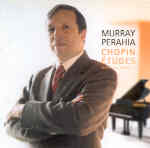Murray Perahia makes a welcome return to Chopin after a series of superb recordings featuring Baroque repertoire, and it’s abundantly clear that he hasn’t lost his touch in Romantic music. While best known as a subtle (detractors might say “bland”) pianist, his playing belies that particular generalization. In fact, he’s most successful in the more virtuosic pieces, from the very first etude with its firmly sculpted left-hand melody to the effortlessly fluid “Thirds” and “Sixths”, an aptly shuddering “Winter Wind” (though for some reason missing bar 66), and a dazzling concluding perpetuum mobile. Less successful, surprisingly, are the lovely Op. 10 No. 3, which suffers from a touch of affectation in phrasing, and a slightly subdued Op. 10 No. 9, which isn’t especially “molto agitato”.
A little more rhythmic definition of the right-hand figurations in Op. 25 No. 3 also would have been appropriate, but then Perahia handles the tricky syncopations in the very next piece with complete confidence. So any reservations really are quibbles: Perahia’s perfectly even chromatic runs and tiny little rhythmic inflection in Op. 10 No. 2 constitute a model of polished technique and good taste, and the great arpeggio étude (Op. 10 No. 11) also benefits from a beautiful evenness of touch and tone. Sonically, it’s impossible to find fault with the rich, warm sound, open top, and resonant bass register that Sony’s engineers have captured. All in all, this is very distinguished playing, and a welcome reminder that Perahia can back up his customary elegance with real muscle when necessary.
































